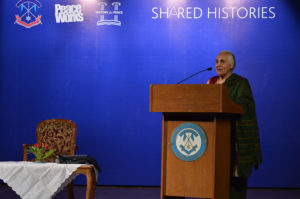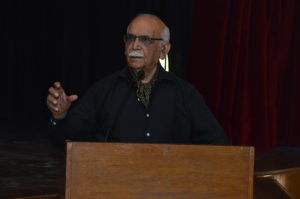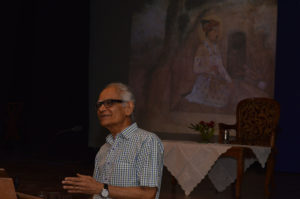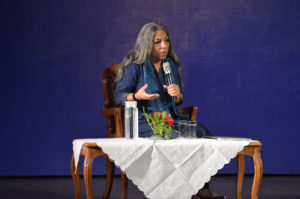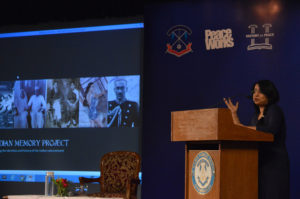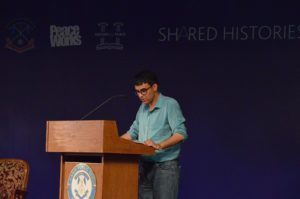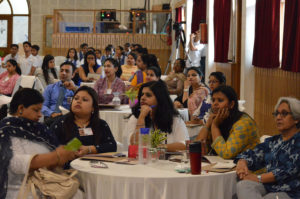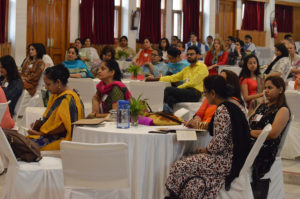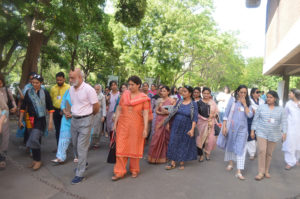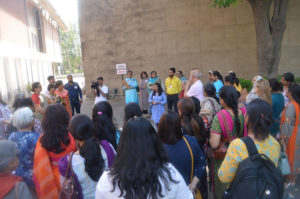We landed in Chandigarh on May Day, on the eve of the two-day history teaching conference we had organized, to be hosted by Saint Kabir Public School, under the rubric of ‘Shared Histories’.
ccccWith a promising turnout of nearly ninety participants, we began the conference at 9:15 a.m on May 2nd with a pertinent opening address by the Principal of St. Kabir’s explaining why the school chose to host this conference in its own socio-political global location.
ccccRomila Thapar began the proceedings of the conference with a historical overview of the Panjab region and the religions that flourished therein, upto the birth of Sikhism in the 15th century. Upsetting the widely established notion[1] that Hinduism, Islam and Sikhism were the three predominant religions practised in the region until 1849, Prof. Thapar cast light on Sufism as distinct from Islam, a category it is often conflated with, and the borrowing of ideas between the Sufis and Nathpanthis, the latter of which cannot accurately be contained within ‘Hinduism’. The origins of varna, the impacts of caste and religion on each other and evolving ideas of ‘alien’ and ‘local’ were explored. This was followed by Indian art historian and critic, Prof. B.N. Goswamy on ‘A Mughal Ramayana and a Jaina Shahnama’—an illustrated talk around exquisite images that challenge monolithic ideas of religion through art form. Comparing pahari depictions of scenes from the Ramayana (where multiple timespans coexist within the same frame) to the same scenes in a Mughal Ramayana (containing text in floating panels), Prof. Goswamy went on to share images from a copy of Firdausi’s Shahnama with illustrations in the Jaina style and the Mughal Ramayana commissioned by Hamida Banu Begum (Akbar’s mother), who is said to have asked for her copy on her deathbed, among many other such results of cross-cultural engagements.
This window into a largely unfamiliar history enthralled the audience. A sumptuous lunch was followed by Prof. Krishna Kumar on the subject of teaching the Partition. Drawing from his book Prejudice and Pride: School histories of the freedom struggle in India and Pakistan, Prof. Kumar shared his analyses of both nations’ ways of remembering their shared history/ies of Partition and of bequeathing this memory to the young through textbooks, in their respective projects of nation-building and assertion.
cccAfter these three very different avenues into shared histories, the ‘world café’ session was conducted with the audience re-organized into groups, each moderated by a facilitator (primarily speakers at the conference). Five broad questions on the place of shared histories in the classroom, in the context of the sessions held until then, were explored. Facilitators shifted tables midway through the two-hour session to ensure each circle received a multiplicity of perspectives. A few tables continued to be engaged in discussion as the two hours concluded and it was time for representatives of each table to share key issues discussed with the larger group.
ccccDay 2 opened with a fascinating insight into an instance of the nascent Indian state’s response to the Partition—the silai centres begun by the new Government to address the problem of the ‘widows of the Partition’. Begun as a measure towards integration into the production process and society, these silai centres employed said widows in the production of uniforms for class IV government service, under the supervision of ‘masterjis’ who would cut the cloth. Through the histories of the women who worked there, Urvashi Butalia traced the history of these silai centres, highlighting the patriarchal notions of ‘chaste’ and ‘corrupt’ that coloured the state’s approach in negotiations with these women who were officially termed a state ‘liability’. After much struggle, they went on to receive low pensions.
cccThis bottom-up lens was taken further and diversified by Anusha Yadav, founder of The Indian Memory Project. She shared with us pictorial stories from her narrative-based visual archive—intimate stories set in and against institutional histories, both affected by the Partition. From Azoori, possibly pre-partition British India’s first ‘item dancer’ who moved to Pakistan in ’47, to stories of the displacement the Partition brought to anglo-Indians who knew no other home—the audience listened, entranced. The conference then moved into a segment on 1947 and the princely states, focused on the cases of Kapurthala and Kashmir. Cynthia M. Frederick, a conservation architect and co-author of Prince, Patron and Patriarch – Maharaja Jagatjit Singh of Kapurthala, spoke about the cosmopolitanism of Maharaja Jagatjit Singh, as manifest in the architecture and society of Kapurthala, and the Partition’s consequences on this ecosystem. Idrees Kanth next addressed the audience on the complexities of engaging with the history of Kashmir beyond the commonly used parameters (even in progressive liberal academia) of ‘conflict/resistance’. Structurally critiquing the approach of most existing academic work on Kashmir, Kanth problematized the act (and politics) of teaching Kashmir history in the classroom. Both parts of this segment saw diverse, active responses from the audience.
- Anusha Yadav sharing stories from the Indian Memory Project that trace a unique history of India through its people(s)
- Cynthia Frederick on Kapurthala, its last maharaja and the Partition
- Idrees Kanth on looking beyond the binary of conflict/resistance in engagement with the history of Kashmir
ccccPost-lunch, the audience was organized into groups of seven around tables as Alisha Sett and Shafat Farooq of the Kashmir Photo Collective (KPC) engaged them in an absorbing workshop around ways to incorporate visual and media literacy in classrooms with ease. Images focused on the Kashmir Valley from the KPC archive dating back to the late nineteenth century—historic images taken by Magnum photographers such as Henri Cartier-Bresson, as well as more recent photographic works (more ambiguous with regards to their documentary value) were distributed to be “read”. After doing a detailed visual analysis of a few images, the teachers were asked to imagine themselves in the following situation:
Each table is representative of the photo editorial team of India’s leading national newspaper and we are in 2046, two hundred years from the signing of the Treaty of Amritsar in which the Valley was officially bought by Maharaja Gulab Singh and the territory of Jammu, Ladakh, and Kashmir as we know them today were stitched together for the first time. As editors, how would they represent the two hundred year history of the Kashmir Valley using a selection of just five or six images? What kind of image would make the front page? What would be the reasons for their choices of one image over another? What did the captions say about the photos that could not be seen within them?
- Participants
- Participants
- Participants
Over the next hour and a half the participants were compelled to confront their own biases, and share their differing readings of this history, concluding with presentations by the teachers encapsulating their discussions. The session was wrapped up with KPC sharing their knowledge of easily accessible digital resources.
ccccFor the concluding session of the conference we set out for the Government Museum and Art Gallery—an institution with a meandering marvelous history shaped by political events. The parched afternoon did little to deter the general enthusiasm as Seema Gera shared stories of this Le Corbusier designed museum— how it owes its existence to the Partition, the decade-plus travelling history of the museum collections from Lahore through three different stops to a permanent home in the Government Museum, of claims made on the museum’s pahari painting collections by Shimla which had temporarily housed the museum collections during its years of being partitioned-Punjab’s official capital post-1947, before the Government museum or even the city of Chandigarh was built. Once inside, activity cards asking participants to note down 6 different ways of bringing a museum object of their choice into classroom proceedings were distributed, before Medhavi led us around, stringing disparate works from around the museum into a narrative of shared histories before and sometimes despite the Partition.
- Chalo Museum!
- Outside the museum that owes its existence to the Partition
- Meena Malhotra, Director-PeaceWorks
ccccAmidst exchanges of observations and contact information over a final grand high tea by our hosts, the conference drew to a close in the rather befitting location of the Government Museum, not far from where SL Parasher’s striking landscape sculpture ‘Un-divided Punjab’ stands facing a captured tank, a relic from the 1965 Indo-Pak war.
[1] Largely by Ganesh Das, author of what is considered among the most important sources of socio-cultural information on Punjab pre-1849 and its annexation to British IndiaPages:

